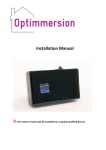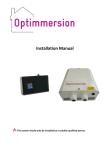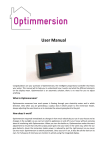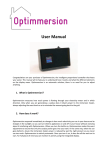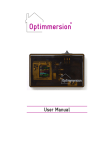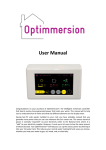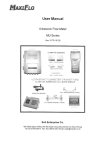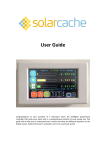Download Installation Manual
Transcript
Installation Manual The system should only be installed by a suitably qualified person. It is recommended you read these instructions before you begin the installation, but in summary: Assess the existing electrical wiring to make sure that it is suitable for the installation of a Optimmersion system. Mount the power throttle in a suitable location. Mount the controller in its chosen location. Install the associated cables and make connections as per figures 1 to 5. (Do not clip on the current transformers yet.) Electrically test the circuitry and then energize the system. Carry out the commissioning steps as described in section (f) below. General information Optimmersion measures how much power is flowing through the electricity meter using a current transformer which clips around the live wire of the feed from the Grid. When there are more than 50 watts being exported, it brings up the immersion heater (water heater), always adjusting the exact level so as to maintain the exported power below about 200 Watts. Electric appliances can be turned on and off in the house and Optimmersion makes the appropriate adjustment. Optimmersion also measures the amount of power being generated by the PV installation using a second clip-on current transformer. This information is displayed, but has no effect on the control of the water-heater. Optimmersion incorporates the display within the controller unit itself which is normally installed near to the consumer unit. This is often in an inconvenient position for seeing the display. What’s in the box? The kit that you have received should contain the following components: 1 x controller unit 1 x power throttle 2 x CT clips with phono plug terminations 1 x phono plug to open wire ended control signal cable 1 x power plug to open wire ended power supply cable 1 x length of 5-core 1.5mm cable PVC cable glands Please identify each of these components. Call 02032860896 if there is a discrepancy. You will also need screws and the appropriate wall fixings. Optimmersion Installation Manual Page 2 of 8 Installation steps 1. Inspection Assess the existing immersion heater circuit to ensure that it is a dedicated radial circuit fed directly from the consumer unit. Any other equipment which is also connected to this circuit must be disconnected and re-wired. We recommend that the controller and associated AC circuitry is protected by a 30 mA RCD. Our chosen modular design allows the controller unit to be mounted away from the consumer unit in a more convenient position so that the display can be seen at a glance with ease. The power throttle should be installed adjacent to the property’s main consumer unit, incoming electrical supply, and the point at which the PV plant’s dedicated supply circuit connects to the consumer unit. 2. Power throttle Warning: the power throttle may run hot at times! Mount the unit on a non-flammable vertical surface and make sure that air is free to run through the vents. If in doubt, we recommend spacing the power throttle from the wall surface by 10 mm. 3. Controller unit Remove the lid by gently pressing in the centre of the upper side of the base. The cover will release from the top, hinging at the bottom. Refit the lid by aligning the two locators at the bottom, gently pushing home at the top. Mount the controller unit carefully on a flat surface so as not to distort the enclosure. Failure to do this may result in damage to the unit and poor fitting of the cover. The cable entry slot is designed to allow the power and phono cables to be threaded through from the rear or from the bottom. The plugs may be inserted into their respective sockets prior to final fixing. We recommend that you first prepare and loosely fix the unit to the wall, and then, before tightening the fixings, thread the plugs through the cable entry slot and insert them into their respective sockets, starting at the top and working down. Optimmersion Installation Manual Page 3 of 8 4. Socket designations: E F G H Figure 1 showing the controller unit. E: Optimmersion low-voltage AC power supply input from the power throttle (underneath) F: Socket for the clip-on current transformer which monitors the PV output G: Socket for the clip-on transformer which monitors the current at the electricity meter H: Low-voltage control signal output to the power throttle. 5. Low-voltage power supply Insert the supply lead plug end into socket E and connect the free ends to the AC O/P screw terminals within the power throttle, as shown in Figures 2 and 3. These may be connected either way around. 6. Wiring & Connections (see the wiring diagrams Figures 2, 3 and 4) A length of 5-core 1.5mm cable is provided together with PVC cable glands. Use this between the consumer unit and the power throttle, intercepting the dedicated water heater circuit. Make the connections as shown in the two wiring diagrams, Figures 2, 3 and 4 below. At this stage, please leave both current transformers plugged in but unclipped. British standard BS 7671: 2008 (amended 2011), regulation 537.3.2.1, allows the circuit-breaker in the consumer unit to act as the means for switching off the Optimmersion and associated circuits for maintenance purposes provided that you mount the power throttle near by the consumer unit. However, if you are mounting the power throttle some way away from the circuit-breaker (for example, in another cupboard or in a room away from the consumer unit), you will need to provide a double-pole isolation switch next to the power throttle as an means for local isolation. Alternatively, you can install a means of locking off the circuit-breaker. Optimmersion Installation Manual Page 4 of 8 Figure 2 power throttle controller unit E F SIGNAL 5V + 0 AC O/P G H connect either way around (not used) LNENL centre + screen/outer 0 power supply cable supply input water heater control cable PV output LNE from consumer unit Figure 3 SIGNAL AC O/P 0 5V + outer control unit L OUT N OUT Earth L IN power supply plug to SolarCache+ connect either way around N IN centre phono plug to SolarCache+ control unit power throttle 5 core 1.5 mm cable consumer unit L supply from water heater MCB N supply EARTH N water heater L water heater Optimmersion Installation Manual Page 5 of 8 Figure 4: Connections in the consumer unit 5 core 1.5 mm cable Existing water heater cable MCB MCB MCB RCB MCB WH E MCB MCB RCB MCB N MCB MCB Main switch N Figure 5: CT clip placement. Solar PV PV generation current transformer Export current transformer CT yes Main fuse Incoming supply MCB MCB MCB RCB MCB WH MCB E MCB MCB N RCB MCB Meter Main switch Block (if fitted) MCB N no CT CT PV MCB Other circuits Optimmersion Installation Manual Page 6 of 8 Commissioning Check that all AC electrical connections are complete and ready for energizing. Carry out appropriate electrical tests of your wiring, according to BS7671:2008 (amended 2011). Switch on the immersion heater MCB in the consumer unit and the power throttle DP isolation switch (if fitted) to energize the system. Slide the slider function switch, located on the top of the controller unit to the mid position. The legend “Heat: automatic” should appear in green at the bottom of the display. If instead the legend “Heat: 1-hr boost” appears, slide the switch to the left and then to the centre. Make sure that the PV system is switched on and generating power. Clip the PV current transformer around the PV supply live wire. (Please refer to Figure 5 for correct placement.) Take care to ensure that the magnet surfaces are clean and engage properly. After a few seconds, the yellow ‘Sun’ display should indicate the value of the power currently being generated by the PV plant. If the display reads zero, the current transformer needs to be unclipped and reversed so that the live wire feeds through from the other direction. (Note that the ‘Sun:’ display alternates every 6 seconds with the ‘Gen:’ display. The yellow bar, however, always shows how much power is being generated.) Clip the electricity supply input current transformer (the export current transformer in Figure 5) around the live wire of the incoming electricity supply cable, between the supply cut-out fuse and the electricity meter, or between the electricity meter and the consumer unit (again ensuring that both magnet surfaces fully engage). If the PV system is generating more power than the house uses, the ‘Net’ display value will be green after a short time (allow up to a minute) indicating that power is being exported. If the house usage is greater than the generated power, then the ‘Net’ display value will be shown in red. You can check that this current transformer is correctly installed by turning on a high power appliance, such as an electric kettle. The ‘Net’ display figure should increase and appear in red as power is being imported from the grid. If the opposite happens (i.e. the Net display goes down, or turns green), then the current transformer requires reversing so that the live wire feeds through from the other direction. Three-position slider function switch The three-position switch is located on the top right-hand side of the controller or on the top righthand side the remote Blue Tooth display unit. It is a slide switch and operates as follows: Left position: the heater is fully on, and Optimmersion has no effect. The legend Heat: continuous appears in red at the bottom of the display, and the blue “Control:” bar should be at full length. Optimmersion Installation Manual Page 7 of 8 Mid position: the heater is controlled automatically by Optimmersion. The legend Heat: automatic or Heat: 1-hr boost (see below) appears in green (or yellow) at the bottom of the display. This is the normal position. Right position: the heater is controlled automatically by Optimmersion. However, the heater is turned fully on between 2 am and 5 am (approximately) under the control of the internal clock. Note that this clock sets itself automatically to solar time after the first sunset-sunrise, or sunrisesunset sequence, after switching on Optimmersion. The accuracy depends on the weather, time of year, and other factors, but the clock should be correct within about an hour of GMT (one hour behind BST). This switch setting is intended for Economy 7 users and should not be used for the first 24 hours or so after switching on. The legend Heat: auto/night appears in yellow at the bottom of the display. The number of hours (0 to 24) until the next night boost is also displayed after the Control: legend. The user can use this to check that the clock has set itself correctly. The legend changes to Heat: eco7 boost during the boost period, and the blue Control: bar should be at full length. Mid-left-mid movement: if the switch is moved from the mid position to the left position and then back to the mid position, the heater is turned fully on for 1 hour. This is useful for all-electric systems to boost the heat. Repeat the process to cancel this function. During the boost period, the legend Heat: 1-hr boost will appear in yellow at the bottom of the display, and the blue Control: bar should be at full length. Optimmersion is sold for professional use and installation. Technical Specifications and Support Power consumption of controller Transfer effi ciency of throttle Max. load current surge (Amp) Max. load constant surge Mains frequency tolerance 50Hz Operating temperature Maximum power dissipation at 3kW output 2 watts 98 % Half a cycle 250, Low repetitive 25 17 amp +/- 1Hz 65 oC operational 588 watts Internal fuse Packaged weight Packaged dimensions (cm) 20 Amps, 1% ceramic 3.4 kg L:34 W:27 H:19 If you have any questions regarding the installation or operation of the Optimmersion system, visit our support site: www.energeno.com/uk/support. Energeno Ltd. 4th Floor 70-74 City Road London EC1Y 2BJ www.energeno.com OMM-ENG 1.1 02-13 Optimmersion Installation Manual Page 8 of 8








